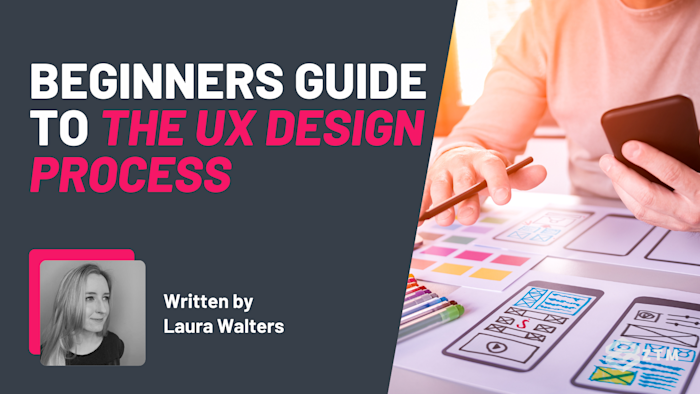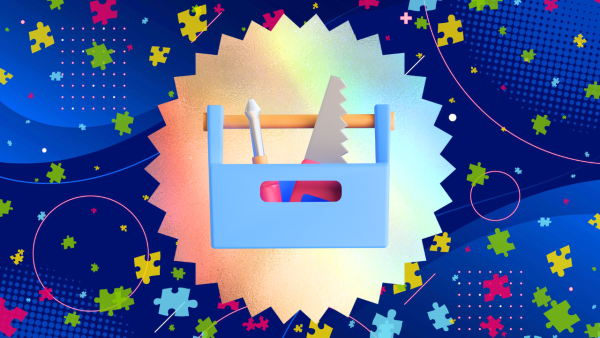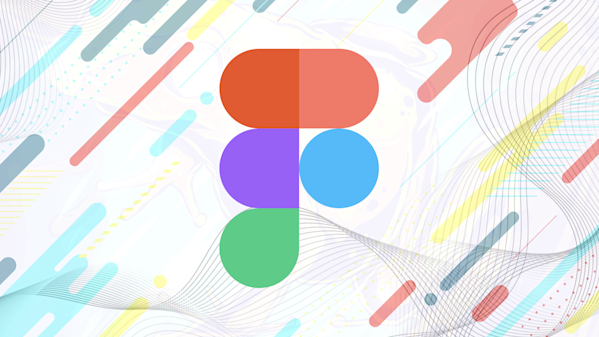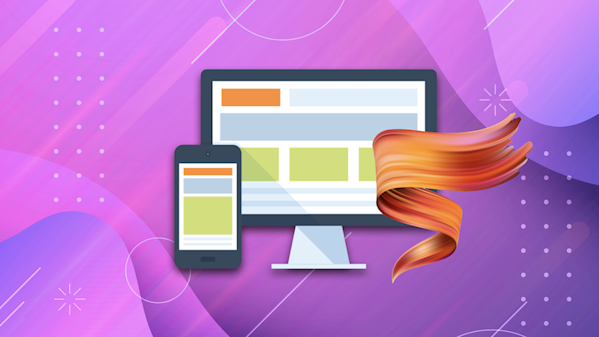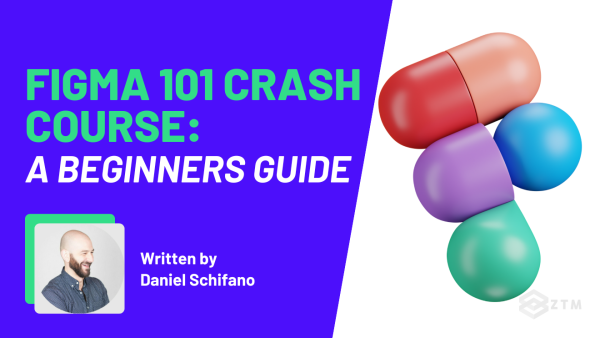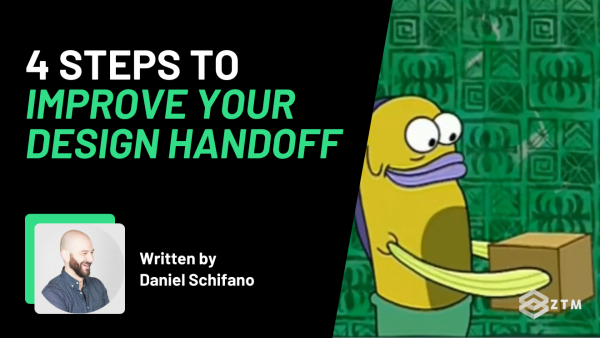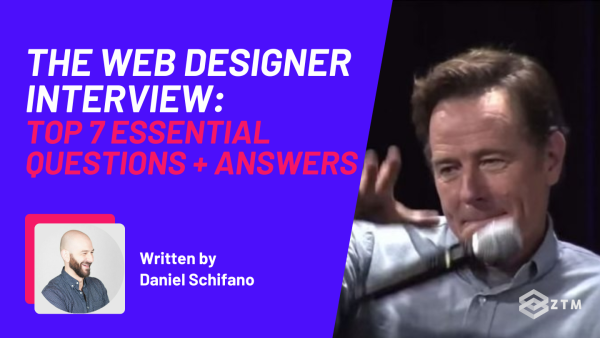Ever tried navigating a website that just doesn’t work the way you expect? Frustrating, right? On the flip side, some apps just feel effortless. Everything clicks and using them is a breeze. That’s the magic of great UX design.
As a beginner UX designer, you’re probably wondering how you can create that same experience for your users. It all starts with mastering the UX design process. This guide will walk you through each step, turning your ideas into designs that not only look good but work seamlessly.
Ready to dive in? Let’s go through the UX design process together, step by step.
So that by the end of this guide, you’ll have everything you need to kickstart your UX design journey.
Sidenote: If you want to learn more about UX design, as well as learn how to use the best tools for web designers, check out Dan Schifano’s complete Design Bootcamp course.
It’s the only design course you need to learn and master web design, mobile design, Figma, UI & UX, and HTML + CSS.
With that out of the way, let’s get into the design process, what it is, and how it works - step-by-step…
What is the UX design process?
The UX design process is a roadmap to creating products that people love to use.
It’s a series of steps that professional designers use to help them understand their users, define their needs, brainstorm ideas, create prototypes, test those prototypes, and refine their designs based on feedback.

You can think of the UX design process like a GPS for your project.
Just as a GPS helps you find the best route to your destination, a well-structured UX design process guides you from the initial concept to the final product, ensuring your solutions are effective and centered around the user.
Why is the UX design process so important?
A well-designed user experience can make your customers happy and increase engagement. Happier customers and increased engagement tends to mean lower churn which ultimately means more revenue for the business. Always follow the money!
On the flip side, poor UX can frustrate customers and lead to high abandonment rates. Over the long-term this can damage your brand’s reputation and you guessed it... lead to less customers and less revenue.
So by mastering the UX design process, you’ll be able to create products that not only meet but exceed customer expectations. This means your business makes more money and then hopefully you'll get promoted and make more money too 😉.
Which leads me to step #1…
Step #1. Research
Research is the foundation of the UX design process. It’s all about getting to know your users—their needs, goals, behaviors, and pain points.
Think of this phase as laying the groundwork for everything that comes next. Without solid research, your designs might look great but fail to hit the mark.
There are many different types of research you can do so it’s important to have a clear idea of what kind of answers you want to get.
For example
When it comes to user research there are many techniques that you can use to get user insights but these are divided into two groups;
- Qualitative research (What do people say they want?)
- Quantitative research (Does the data back this up?)
Qualitative research
Qualitative research involves asking questions to generate a picture of how users think, feel and behave.
Imagine this scenario: You’re designing a new fitness app but you’re not sure what features it needs. So you start by talking to gym-goers, asking them about their workout routines, challenges with current apps, and what features they wish they had.
One person mentions how annoying it is to manually log workouts, while another wants more options for sharing progress on social media.
These insights are gold, and help you plan to bypass common issues and provide what the audience actually wants. Things that you might never have thought to add yourself.

Quantitative research
Quantitative research helps to generate more data-driven answers so that you can verify ideas.
For example
If you aren’t able to talk to gym-goers in person or if you want to gather insights from a wider audience you could send out online surveys.
Depending on the questions you ask you could end up with a valuable combination of qualitative and quantitative insights.
Perhaps you asked respondents to rate their experience with the app they’re currently using to track their progress. You might find out that 75% of respondents are dissatisfied.
You could then follow up on that rating question with one to allow them to elaborate: “What app are you currently using?” and “Why did you give this rating?”
You will then end up with a goldmine of insights and useful data.
Affinity mapping
The next step is to organize it all so that you and your team can interpret it and figure out what the biggest opportunity is or what is the most potentially impactful solution.
For this, you can use a technique called affinity mapping to visually organize these ideas into groups.

Affinity mapping helps visually organize ideas into groups based on patterns or similarities, enabling your team to identify the most impactful opportunities.
Note that this is different from mind mapping, which is typically used to brainstorm and expand on a central idea. Here we're looking for multiple large opportunities.
Competitive research
Probably the easiest type of research you can do and something that's always good to do (at the very least as a sanity check) is to check out the the competition!
For example
You could check out top fitness apps, studying their user interface designs, features, and user reviews. This analysis might then reveal a gap that you can leverage - such as most apps offer basic tracking, but few provide personalized coaching.
Reading negative reviews from competitive apps can be a gold mine to find missing or poorly designed features that your app might be able to do a much better job at.
It's also good to read the things people are loving about these apps. No need to re-invent the wheel on the things that are already clearly working.
TL;DR
Your learnings through the research phase will help guide you through the rest of the design process.
The better your research process is, the more likely it is that you'll ultimately design an app/website that ends up being successful.
The amount of time spent on research will vary for every project depending on the size, deadline, resources, etc. I've worked on projects where this research phase took over a month and others where it was just a few hours.
Step #2. Ideation
With your research in hand, it’s time to let your creativity shine in the ideation phase. This is where you and your team brainstorm a wide range of ideas and solutions based on the insights you’ve gathered.

This is the time to let your creativity flow. Jot down every idea that comes to mind—no matter how wild or unconventional.
- Maybe you’re thinking of adding gamification, where users earn points for workouts
- Or perhaps a feature that lets them share achievements on social media
The key here is quantity over quality at first—the more ideas, the better. Your goal is to explore different angles and uncover potential solutions, no matter how out there they seem.
TL;DR
The ideation phase is all about exploring possibilities and pushing creative boundaries. This is where the magic begins, turning user needs and insights into innovative design concepts.
After that, it’s time to take this visualization to the next step…
Step #3. Prototyping
Now that you have a treasure trove of ideas, it’s time to bring them to life with prototyping. This is where you create preliminary versions of your product to test and refine.
Initial sketches
Prototypes can be anything from simple paper sketches to interactive digital models, depending on what you need.

Rough sketches of various layouts and interfaces make abstract ideas tangible, letting you see what might work.
For example
For your fitness app, you might sketch out a dashboard that shows daily workout summaries, a social feed for sharing achievements, and a customizable workout plan interface.
These sketches aren’t final designs - they’re just a starting point, but they also implement the points you gathered from the research.
Sidenote: I'm covering the main parts of this processs in this guide, but obviously each element is a lot more detailed.
You can see here in Dan's Design course, sketching takes up 7 videos because of how important it is to the process:

Wireframes
Once you have finalized some rough layout sketch ideas, you can then take the prototype to the next level with wireframes.
These are low-fidelity versions of your layout and structure, focusing on functionality. You’ll see where different elements will be placed without worrying about the granular details like color and typography.

UI mockups
Next, you create UI mockups. These are high-fidelity visual designs that show what the ‘live’ app will look like. It’s your idea that comes to life with icons, fonts, and colors, all giving a clear picture of the final product.

Interactive prototypes
Then come the interactive prototypes. Using tools like Figma or AdobeXD, you create clickable models that simulate the user experience. Users can navigate the app, perform tasks, and provide feedback on the design.

Step #4. Testing and perfecting your design
After creating your prototypes, the next crucial step is testing. This phase is all about evaluating your designs with real users to gather feedback and spot usability issues.
This is important because testing ensures your design meets user needs and expectations before you dive into full-scale development of the design.
Usability tests
Usability tests allow real users to interact with the prototype while you watch and observe any issues.
You might ask them to complete specific tasks, like setting up a workout plan or logging a workout. As they navigate the app, you note any difficulties they encounter and gather their feedback on the design and features.

For example
During testing, you might notice that some users are struggling with the navigation menu and finding it unintuitive. They might also say the workout logging process is too cumbersome.
This feedback highlights areas that need improvement. You then take detailed notes and prepare to iterate on your design based on these insights.
Sidenote: Even if you're doing these usability tests in person, it's always worth screen recording the user experience. This way you might see things on future viewings that you might have missed. Where they struggling to click on things etc.
They are specialist tools for this, but if you're doing this on a budget for your own projects, the one I linked above is free to use.
A/B testing design elements
In addition to usability testing, A/B testing can be super helpful. You create two versions of a design element and compare their performance.
For instance, you might test two different layouts for the workout summary screen to see which one users prefer and find easier to use.
Feedback sessions
Another great method is holding feedback sessions. After users have interacted with the prototype, you sit down with them to discuss their experiences in more detail.
These sessions provide deeper insights into user preferences and pain points.
TL;DR
Testing is an iterative process. Based on the feedback you gather, you make necessary adjustments to the design. You might simplify the navigation menu, streamline the workout logging process, and make other tweaks to enhance usability.
However, these iterations ensure that by the time you move to full-scale development, your design is as polished and user-friendly as possible - increasing your chances that it will be successful
Step #5. Implementation and bringing your design to life
With your design finalized, it’s time to move to the implementation phase. This is where your design is handed over to front-end developers, (either in-house or an agency), for coding and integration.
However, just because it’s handed off that doesn’t mean you’re no longer part of the design process. In fact, close collaboration between you, the designer, and the developers is crucial to ensure the design is accurately translated into a working product.
Regular communication is key, so you might have weekly check-ins or use project management/Design tools like Figma to track progress and tackle any issues that come up. This helps make sure the design vision is faithfully executed in the final product.

Quality Assurance
Once the app is built, it undergoes rigorous Quality assurance (QA) testing to spot and fix any bugs or issues. This ensures the app looks great and works seamlessly.
Testers will go through every feature, from setting up a workout plan to logging workouts and sharing achievements. They look for any discrepancies between the design and the final product, making sure everything works as intended.
Step #6. Iteration and continuously improving your product
Even after your product is launched, the UX design process isn’t over. This is because we can always improve - making sure we continue to meet user needs and stay competitive in the market.
For example
Once your fitness app is live, you start collecting user feedback through various channels, like in-app surveys, user reviews, and support tickets.
You also monitor analytics to see how users are interacting with the app.
- Are they using all the features?
- Where are they dropping off?
This data gives you valuable insights into how the app is performing and where you can make improvements.

You might notice users love the workout logging feature but aren’t really engaging with the social sharing aspect.
Why is this?
Based on early research, we know it's a feature that people have asked for, so perhaps it’s a design issue and it's not fully visible?
Based on this feedback, you decide:
- To enhance the social sharing functionality, making it larger on screen to see and easier to use
- You might also add new features, like integrating with social media platforms or allowing users to share workout milestones
TL;DR
Regular updates are key to this iterative process. By continuously improving your app based on user feedback and analytics, you ensure it stays relevant and valuable to your users.
This approach helps you stay responsive to user needs and maintain a high level of user satisfaction.
Ready to create experiences your users will love?
Getting the hang of the UX design process helps you create products that really click with users.
By honing your skills in research, ideation, prototyping, testing, and iteration, you’ll ensure every design is user-centered which will give you the best chance at having a successful product/app.
But this post only scratched the surface. There's so much to learn at each of these steps. The best part is that UX Designers are in high demand and get paid well too.
So if this post has you hungry for more, I highly recommend you make a very small investment into taking Dan's Complete UI/UX Design Bootcamp. If it existed when I was first learning design, it would have saved me a ton of time.
It will take you from a complete beginner in every topic I've highlighted in this post (and waaaayyyy more) to the point where you can get hired as a UX/UI Product Designer.
The best part is that you also get access to ZTM's private Discord community with 1,000s designers, developers, and other tech professionals.
Most importantly, you'll get access to Daniel himself as well as other alumni and mentors so you'll never feel stuck along the way which is so common with most online courses (especially free ones)!
Bonus: if you join the Zero To Mastery Academy, you’ll not only have access to Dan's Design Bootcamp but also the entire ZTM course library including ALL of Dan's design courses. I'm a big dan of his personal branding and Motion Design courses.
